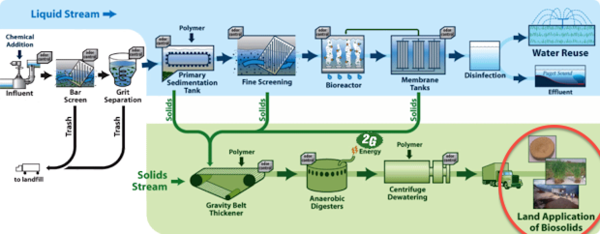2G-Cenergy
|
WARNING! Sewage sludge is toxic. Food should not be grown in "biosolids." Join the Food Rights Network. |
2G-Cenergy is a corporation involved in the sewage sludge industry. By its own description, it is a leader in the area of sewage biogas technology. "Sewage gas is biogas produced by the digestion and incineration of sewage sludge. This biogas can be used to generate energy. . . . The anaerobic digestion of sewage sludge involves fermenting it in tanks at a temperature between 32 and 36 degrees centigrade." [1]
Contents
Toxic Sludge Gasification Controversy
EPA whistleblower Hugh Kaufman has called gasification, or using sludge to generate methanol or energy, the "most environmentally sound approach, but also the most expensive," to sludge disposal. However, anaerobic digestion of sewage sludge, while it reduces the volume of the sludge and heats it to a temperature that kills many pathogens, still leaves behind what the industry calls "digestate" or, more specifically in this case, "biosolids." These "Class A Biosolids" (so-called because the Environmental Protection Agency has stricter limits on pathogens and "vector attraction" for Class A than for Class B Biosolids, i.e. they must not attract disease-carrying insects or rodents, etc.) still contain other sludge contaminants, including Dioxins and Furans, Flame Retardants, Metals, Organochlorine Pesticides, 1,2-Dibromo-3-Chloropropane (DBCP), Naphthalene, Triclosan, Nonylphenols, Phthalates, Nanosilver, and thousands more substances.
The EPA's 2009 Targeted National Sewage Sludge Survey (TNSSS) concluded that all sewage sludge, Class A, Class B or otherwise, contains toxic and hazardous materials, including large numbers of endocrine disruptors. The TNSSS results are described in two EPA reports published in 2009. EPA found that dozens of hazardous materials, not regulated and not required to be tested for, have been documented in each and every one of the sludge samples EPA took around the USA.[2] And yet Class A "Biosolids" may be applied to cropland with no restrictions and sold or given away to gardeners as "organic fertilizers," and hundreds of municipalities and companies do so.
2G-Cenergy advocates "Land Application of Biosolids." The following image is from its website, annotated by the Center for Media and Democracy:
Exhibitor at 2011 BioCycle 11th Annual Conference on "Renewable Energy from Organics Recycling"
2G-Cenergy was an exhibitor at the 2011 BioCycle 11th Annual Conference on "Renewable Energy from Organics Recycling." BioCycle Magazine is a publication serving the interests of the sewage sludge industry.[3]
Resources
Other SourceWatch Resources
References
- ↑ 2G-Cenergy, More Information About Sewage Gas, corporate website, accessed November 2, 2011
- ↑ Environmental Protection Agency, TNSSS: EPA-822-R-08-016 and EPA-822-R-08-018, January 2009
- ↑ BioCycle, Exhibitor Directory, publisher's website, accessed November 3, 2011
| This article is a stub. You can help by expanding it. |

